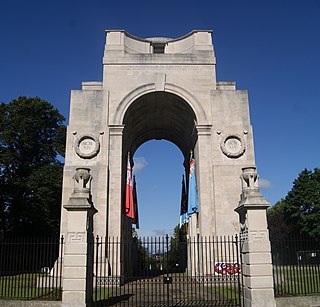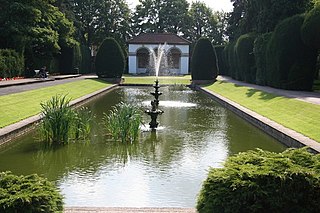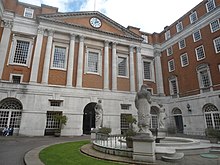
Sir Edwin Landseer Lutyens was an English architect known for imaginatively adapting traditional architectural styles to the requirements of his era. He designed many English country houses, war memorials and public buildings. In his biography, the writer Christopher Hussey wrote, "In his lifetime (Lutyens) was widely held to be our greatest architect since Wren if not, as many maintained, his superior". The architectural historian Gavin Stamp described him as "surely the greatest British architect of the twentieth century".

The Tower Hill Memorial is a pair of Commonwealth War Graves Commission memorials in Trinity Square Gardens, on Tower Hill in London, England. The memorials, one for the First World War and one for the Second, commemorate civilian, merchant seafarers and fishermen who were killed as a result of enemy action and have no known grave. The first, the Mercantile Marine War Memorial, was designed by Sir Edwin Lutyens and unveiled in 1928; the second, the Merchant Seamen's Memorial, was designed by Sir Edward Maufe and unveiled in 1955. A third memorial, commemorating merchant seamen who were killed in the 1982 Falklands War, was added to the site in 2005.

Bloomsbury Square is a garden square in Bloomsbury, in the London Borough of Camden, London. Developed in the late 17th century, it was initially known as Southampton Square and was one of the earliest London squares. By the early 19th century, Bedford House along the north of the square had been demolished and replaced with terraced housing designed by James Burton.

Tavistock Square is a public square in Bloomsbury, in the London Borough of Camden.
The British Medical Association (BMA) is a registered trade union for doctors in the United Kingdom. The association does not regulate or certify doctors, a responsibility which lies with the General Medical Council. The association's headquarters are in Tavistock Square, London and it has national offices in Cardiff, Belfast, and Edinburgh, a European office in Brussels and a number of offices in English regions. The BMA has a range of representative and scientific committees and is recognised by National Health Service (NHS) employers as the sole contract negotiator for doctors.
James Arthur Woodford (1893–1976) was an English sculptor. His works include sets of bronze doors for the headquarters of the Royal Institute of British Architects and Norwich City Hall; the Queen's Beasts, originally made for the Coronation in 1953, and later replicated in stone, and the statue of Robin Hood outside Nottingham Castle.

Manchester Cenotaph is a war memorial in St Peter's Square, Manchester, England. Manchester was late in commissioning a First World War memorial compared with most British towns and cities; the city council did not convene a war memorial committee until 1922. The committee quickly achieved its target of raising £10,000 but finding a suitable location for the monument proved controversial. The preferred site in Albert Square would have required the removal and relocation of other statues and monuments, and was opposed by the city's artistic bodies. The next choice was Piccadilly Gardens, an area already identified for a possible art gallery and library; but in the interests of speedier delivery, the memorial committee settled on St Peter's Square. The area within the square had been had been purchased by the City Council in 1906, having been the site of the former St Peter's Church; whose sealed burial crypts remained with burials untouched and marked above ground by a memorial stone cross. Negotiations to remove these stalled so the construction of the cenotaph proceeded with the cross and burials in situ.

Rochdale Cenotaph is a First World War memorial on the Esplanade in Rochdale, Greater Manchester, in the north west of England. Designed by Sir Edwin Lutyens, it is one of seven memorials in England based on his Cenotaph in London and one of his more ambitious designs. The memorial was unveiled in 1922 and consists of a raised platform bearing Lutyens' characteristic Stone of Remembrance next to a 10-metre (33 ft) pylon topped by an effigy of a recumbent soldier. A set of painted stone flags surrounds the pylon.

The Royal Naval Division Memorial is a First World War memorial located on Horse Guards Parade in central London, and dedicated to members of the 63rd Division (RND) killed in that conflict. Sir Edwin Lutyens designed the memorial, which was unveiled on 25 April 1925—ten years to the day after the Gallipoli landings, in which the division suffered heavy casualties. Shortly after the war, former members of the division established a committee, chaired by one of their leading officers, Brigadier-General Arthur Asquith, to raise funds for a memorial. Progress was initially slow. The committee planned to incorporate its memorial into a larger monument proposed by the Royal Navy for Trafalgar Square. When the navy abandoned that project, the RND's committee decided to proceed independently. They engaged Lutyens, who, after negotiation with the Office of Works, produced a design for a fountain connected to the balustrade of the Admiralty Extension building.

The Civil Service Rifles War Memorial is a First World War memorial located on the riverside terrace at Somerset House in central London, England. Designed by Sir Edwin Lutyens and unveiled in 1924, the memorial commemorates the 1,240 members of the Prince of Wales' Own Civil Service Rifles regiment who were killed in the First World War. They were Territorial Force reservists, drawn largely from the British Civil Service, which at that time had many staff based at Somerset House.

Marshcourt, also spelled Marsh Court, is an Arts and Crafts style country house in Marsh Court, near Stockbridge, Hampshire, England. It is constructed from quarried chalk. Designed and built by architect Edwin Lutyens between 1901 and 1905, it is a Grade I listed building. The gardens, designed by Lutyens and Gertrude Jekyll, are Grade II* listed in the National Register of Historic Parks and Gardens.

The Arch of Remembrance is a First World War memorial designed by Sir Edwin Lutyens and located in Victoria Park, Leicester, in the East Midlands of England. Leicester's industry contributed significantly to the British war effort. A temporary war memorial was erected in 1917, and a committee was formed in 1919 to propose a permanent memorial. The committee resolved to appoint Lutyens as architect and to site the memorial in Victoria Park. Lutyens's first proposal was accepted by the committee but was scaled back and eventually cancelled due to a shortage of funds. The committee then asked Lutyens to design a memorial arch, which he presented to a public meeting in 1923.

Spalding War Memorial is a First World War memorial in the gardens of Ayscoughfee Hall in Spalding, Lincolnshire, in eastern England. It was designed by the architect Sir Edwin Lutyens. The proposal for a memorial to Spalding's war dead originated in January 1918 with Barbara McLaren, whose husband and the town's Member of Parliament, Francis McLaren, was killed in a flying accident during the war. She engaged Lutyens via a family connection and the architect produced a plan for a grand memorial cloister surrounding a circular pond, in the middle of which would be a cross. The memorial was to be built in the formal gardens of Ayscoughfee Hall, which was owned by the local district council. When McLaren approached the council with her proposal, it generated considerable debate within the community and several alternative schemes were suggested. After a public meeting and a vote in 1919, a reduced-scale version of McLaren's proposal emerged as the preferred option, in conjunction with a clock on the town's corn exchange building.

Northampton War Memorial, officially the Town and County War Memorial, is a First World War memorial on Wood Hill in the centre of Northampton, the county town of Northamptonshire, in central England. Designed by architect Sir Edwin Lutyens, it is a Stone of Remembrance flanked by twin obelisks draped with painted stone flags standing in a small garden in what was once part of the churchyard of All Saints' Church.

Mells War Memorial is a First World War memorial by Sir Edwin Lutyens in the village of Mells in the Mendip Hills of Somerset, south-western England. Unveiled in 1921, the memorial is one of multiple buildings and structures Lutyens designed in Mells. His friendship with two prominent families in the area, the Horners and the Asquiths, led to a series of commissions; among his other works in the village are memorials to two sons—one from each family—killed in the war. Lutyens toured the village with local dignitaries in search of a suitable site for the war memorial, after which he was prompted to remark "all their young men were killed".

The York City War Memorial is a First World War memorial designed by Sir Edwin Lutyens and located in York in the north of England. Proposals for commemorating York's war dead originated in 1919 but proved controversial. Initial discussions focused on whether a memorial should be a monument or should take on some utilitarian purpose. Several functional proposals were examined until a public meeting in January 1920 opted for a monument. The city engineer produced a cost estimate and the war memorial committee engaged Lutyens, who had recently been commissioned by the North Eastern Railway (NER) to design their own war memorial, also to be sited in York.

The North Eastern Railway War Memorial is a First World War memorial in York in northern England. It was designed by Sir Edwin Lutyens to commemorate employees of the North Eastern Railway (NER) who left to fight in the First World War and were killed while serving. The NER board voted in early 1920 to allocate £20,000 for a memorial and commissioned Lutyens. The committee for the York City War Memorial followed suit and also appointed Lutyens, but both schemes became embroiled in controversy. Concerns were raised from within the community about the effect of the NER memorial on the city walls and its impact on the proposed scheme for the city's war memorial, given that the two memorials were planned to be 100 yards apart and the city's budget was a tenth of the NER's. The controversy was resolved after Lutyens modified his plans for the NER memorial to move it away from the walls and the city opted for a revised scheme on land just outside the walls; coincidentally the land was owned by the NER, whose board donated it to the city.

Holy Island War Memorial, or Lindisfarne War Memorial, is a First World War memorial on the tidal island of Lindisfarne off the coast of Northumberland in the far north east of England. Designed by Sir Edwin Lutyens, the memorial is a grade II* listed building.

The Lancashire Fusiliers War Memorial is a First World War memorial dedicated to members of the Lancashire Fusiliers killed in that conflict. Outside the Fusilier Museum in Bury, Greater Manchester, in North West England, it was unveiled in 1922—on the seventh anniversary of the landing at Cape Helles, part of the Gallipoli Campaign in which the regiment suffered particularly heavy casualties. The memorial was designed by Sir Edwin Lutyens. Lutyens was commissioned in light of a family connection—his father and great uncle were officers in the Lancashire Fusiliers, a fact noted on a plaque nearby. He designed a tall, slender obelisk in Portland stone. The regiment's cap badge is carved near the top on the front and rear, surrounded by a laurel wreath. Further down are inscriptions containing the regiment's motto and a dedication. Two painted stone flags hang from the sides.

Stockbridge War Memorial is a First World War memorial in the town of Stockbridge in Hampshire in southern England. The memorial was designed by Sir Edwin Lutyens and unveiled in 1921; it is a grade II listed building.



















